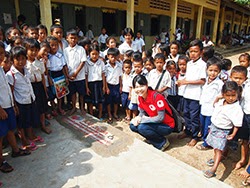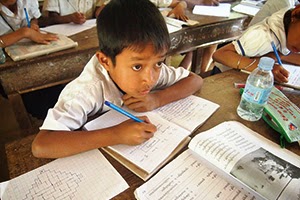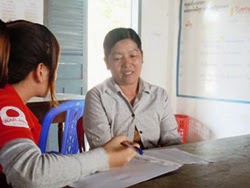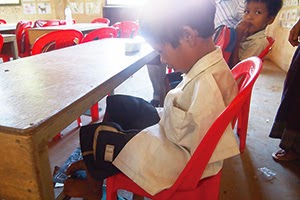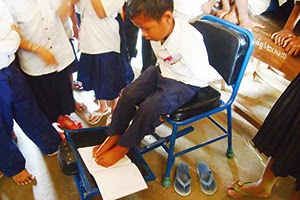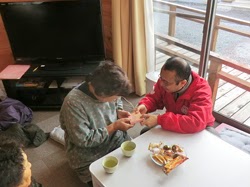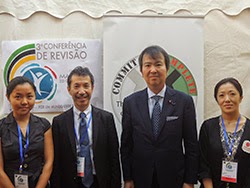AAR Japan started its assistance in Haiti soon after the massive earthquake hit the country in January 2010, and its operation are still ongoing. Since February 2013, we have equipped latrines and fitted hand-washing stations at schools, together with organizing training workshops for school teachers on hygiene education as well as for schoolmasters and administration staff on school management. Our intention is to prevent the spread of cholera in Haiti, where half the number of cholera infections in the world is believed to exist.
In the long perspective, we aim to involve local residents and improve the hygiene conditions of the entire community. Ryota Hirama from AAR’s Haiti office reports.
It is said that the name of the river comes from the fact that rivers are very important for Haitian people, as they are used to cool down their bodies. The river is one of the most important water sources for people in the area. When we pass through the neighborhood, we see a lot of women washing clothes along the riverside. A girl once told us that she was going for a shower when she was on her way to the river. The river is indeed attached to Haitian people’s everyday lives.
According to a research study, 78% of the local residents do not understand the correlation between bodily waste and pollution of the river. In fact, an interview we conducted the other day revealed the fact that some families even drink the river water.
On the other hand, a female interviewee said to us, “I know the water of the river is dirty, but I have no choice but to use it, because I have no money to buy clean water.” Hence it seems incorrect to conclude that people drink the river water due to the lack of knowledge.
AAR has built and repaired the latrines at eight elementary schools in the Carrefour region, and equipped them with tanks to store rainwater for washing hands. We have also organized workshops for school teachers on effective hygiene education. In Haiti, hygiene education is already included in the official school curriculum, which is overseen by the Ministry of Education. However, hygiene classes are not conducted in many schools, and even where they are conducted, in many cases teachers only give a one-way lecture to the students, which is evidently ineffective. Addressing these situations, AAR introduced a more “inclusive way” of hygiene education to the teachers, through using pictures or giving questions to children, for example; so that students can actively participate in class and learn about sanitation and hygiene issues more proactively.
AAR also organized a “hygiene club” to promote student-centered hygiene awareness activities. Members of the club play active roles, such as informing each other about sanitation issues, and taking responsibility for cleaning up the school.
The latrines and the hand-washing stations must be properly maintained even after AAR’s support ends. To maintain equipment clean at schools, schools must secure a sufficient budget for purchasing sanitary products, such as soaps and cleaning equipment. In order to taking these actions, AAR organizes workshops for school staff members who are involved in operational management.
10 months have passed since the start of the project. Students who rarely washed their hands before have now come to wash their hands willingly and regularly. The hygiene club has led children to realize that “WE are in charge of cleaning our school,” and now we even see some children fighting over brooms to clean up their classroom. We are encouraged by their positive attitude.
“We used to be able to drink this river water,” says a staff member at our Haiti office. We hope that our hygiene education will contribute to the prevention of river pollution, and regaining the clean river that people used to enjoy.
Children of Candy Ophanor Elementary School, one of the schools which AARn supported, sing a song which they made for AAR. The lyrics is, ” Thanks to AAR, we can use clean bathrooms, wash hands and prevent diseases. Thank you.”
In the long perspective, we aim to involve local residents and improve the hygiene conditions of the entire community. Ryota Hirama from AAR’s Haiti office reports.
River is crucial for the local residents
The target area of AAR’s activity is Rivière Froid in the Carrefour region, a suburb of Port-au-Prince, the capital city. Rivière Froid means “cold river” in English. As the name suggests, a river flows in the middle of this area.It is said that the name of the river comes from the fact that rivers are very important for Haitian people, as they are used to cool down their bodies. The river is one of the most important water sources for people in the area. When we pass through the neighborhood, we see a lot of women washing clothes along the riverside. A girl once told us that she was going for a shower when she was on her way to the river. The river is indeed attached to Haitian people’s everyday lives.
 |
| The river is essential for the life of people in Haiti. |
River is a garbage dump and toilet
However, it is a sad fact that the river is also a place for garbage dumping and bodily waste. It is a serious problem. As the availability of toilets in the area is extremely low, many people have no choice other than to urinate and defecate in the open air. Consequently, when it rains, bodily waste mixes with the rain water, flows into the river, and contaminates the water, - making it one of the sources of cholera infection. As a result, the rate of cholera infection in the area goes up significantly during the rainy season.According to a research study, 78% of the local residents do not understand the correlation between bodily waste and pollution of the river. In fact, an interview we conducted the other day revealed the fact that some families even drink the river water.
On the other hand, a female interviewee said to us, “I know the water of the river is dirty, but I have no choice but to use it, because I have no money to buy clean water.” Hence it seems incorrect to conclude that people drink the river water due to the lack of knowledge.
 |
| Despite the water being used for washing clothes and showering, there is garbage in the river. It is also a toilet for both people and farm animals. |
As a result of hygiene education, children have come to love cleaning. They even fight over brooms, saying “I will do it!”
We can prevent the spread of cholera by teaching appropriate actions, such as using bathrooms and washing hands after performing bodily functions and before meals. AAR Japan aims to spread knowledge on sanitation and to promote awareness at schools, within families, and eventually throughout the entire local community.AAR has built and repaired the latrines at eight elementary schools in the Carrefour region, and equipped them with tanks to store rainwater for washing hands. We have also organized workshops for school teachers on effective hygiene education. In Haiti, hygiene education is already included in the official school curriculum, which is overseen by the Ministry of Education. However, hygiene classes are not conducted in many schools, and even where they are conducted, in many cases teachers only give a one-way lecture to the students, which is evidently ineffective. Addressing these situations, AAR introduced a more “inclusive way” of hygiene education to the teachers, through using pictures or giving questions to children, for example; so that students can actively participate in class and learn about sanitation and hygiene issues more proactively.
AAR also organized a “hygiene club” to promote student-centered hygiene awareness activities. Members of the club play active roles, such as informing each other about sanitation issues, and taking responsibility for cleaning up the school.
The latrines and the hand-washing stations must be properly maintained even after AAR’s support ends. To maintain equipment clean at schools, schools must secure a sufficient budget for purchasing sanitary products, such as soaps and cleaning equipment. In order to taking these actions, AAR organizes workshops for school staff members who are involved in operational management.
10 months have passed since the start of the project. Students who rarely washed their hands before have now come to wash their hands willingly and regularly. The hygiene club has led children to realize that “WE are in charge of cleaning our school,” and now we even see some children fighting over brooms to clean up their classroom. We are encouraged by their positive attitude.
“We used to be able to drink this river water,” says a staff member at our Haiti office. We hope that our hygiene education will contribute to the prevention of river pollution, and regaining the clean river that people used to enjoy.
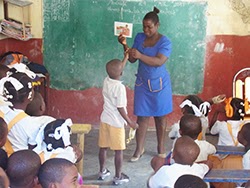 |
| We conduct hygiene education workshops for the teachers, so that they can teach the information to their students, and reduce the risk of infectious diseases in the community. |







